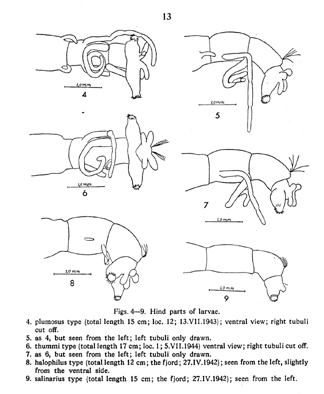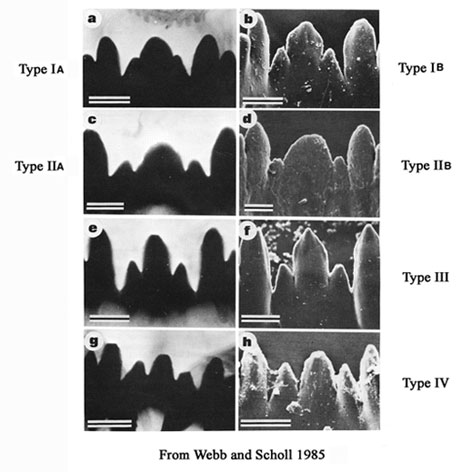Fourth instar larval types of ChironomusSeveral larval types are recognised, based on the presence or absence of lateral and ventral tubules (VT) of the 10th and 11th abdominal segments. The following classifications are based on Proulx et al.(2013). The categories are:
Lacking lateral and ventral tubules:
salinarius (Fig. 9) Lacking lateral tubules on segment 10:
halophilus - anterior VT very short or absent, posterior VT short, less than width of segment (Fig. 8).
bathophilus - moderate to long, essentially straight VT, greater than width of segment.
fluviatilis - VT slightly curved and coming to a point at ends.
thummi - long, anterior VT with 'elbows', posterior VT coiled (Figs. 6 & 7). Possessing lateral tubules on segment 10:
reductus - lacking ventral tubules.
semireductus - short straight or slightly curved VT, less than width of segment.
melanotus - moderate to long, essentially straight VT.
plumosus - long; anterior VT with 'elbows', posterior VT coiled (Figs. 4 & 5). 
From Andersen (1949)
Reference is also made to the mentum and mandible types originally devised by Webb & Scholl (1985), Vallenduuk & Moller Pillot (1997) and Proulx et al. (2013). These classifications were made for relatively small numbers of species, but with the much larger number of species they do not cover all the variability seen in these characters and so further modification has been necessary. As well ventromental and premandible characters are included:
The mentum type is defined only by the degree of development of the 4th lateral teeth:
Type I - height in same line as the rest of the lateral teeth;
Type II - 4th laterals reduced, height about equal to that of the 5th laterals;
Type III - 4th laterals further reduced, height less than that of the 5th laterals.
From Vallenduuk and Moller Pillot (1997)
The mentum may be further classified by the characters of the central trifid tooth:
Type IA - c2 teeth only partially separate from c1, i.e. as shoulders on c1. (figure a)
Type IB - c2 teeth slightly more separated (figure b).
Type IIA - c1 broad, c2 teeth distinctly separated (figure c).
Type IIB - c1 very broad, c2 less separated (figure d).
Type III - c1 tooth relatively narrow and much higher than the separated c2 teeth (figs e and f).
Type IV - c2 teeth well separated, not much lower than the relatively narrow c1 tooth (figs g and h). 
From Webb and Scholl (1985)
The mandible type is defined by the degree of darkening and separation of the 3rd inner tooth. It appears preferable to consider these as separate characters:
Separation
Type I - almost completely fused on lower margin;
Type II - tooth partly free on lower margin;
Type III - 3rd tooth completely separate.
Color
Type A - pale
Type B - slightly darkened
Type C - as dark as other teeth 
From Webb and Scholl (1985)
I - type IA; II - type IIB; III - type IIIC
Mandible length and Mdt-Mat:
Mandible length is measured from the heel to the tip of the apical tooth.
Hirvenoja and Michailova (1998) illustrated that the distance between the tip of the dorsal tooth and the apical tooth could differ between related species (Mdt-Mat) (blue line in figure below).

However for different sized species it may be preferable to divide this value by the length of the inner tooth row (black line in figure above) to obtain the MTR.Ventromentum
There are several measures that can be made from the ventromental plates including VPA and the number of striae. Two others need some explanation:
Ventromental plate ratio (VMR) - ratio of the width of the marginal region of ventromentum (usually seen as a granular band under light microscopy) (a in figure below) to the distance from the anterior margin to the base of the striae (b in figure below). VMR = a/bNote: "b’ is also used as a measure of the depth of the VM in comparing length to depth.‘b’ also serves as a measure of the depth of the VM for the ratio of length to depth of the VM plates.VM length (VML) is measured directly from inner margin to outer margin: This seems preferable to the sometimes used ‘horizontal length’ which can be subject to parallax error and to the effects of rotation of the plates under pressure during slide mounting.Pecten epipharyngis (PE) - Proulx et al. (2013) recognised 4 types of PE. These are useful if the teeth are not worn down, as they often are in older larvae.Type A - fine sharp rather uniform teeth. Type B - teeth broader but still sharp. Sometimes with one or two fine smaller teeth interspersed. Type C - rounded and rather uniform. Worn type B teeth may be mistaken for this type. Type D - rounded teeth with smaller teeth interspersed (generally found in the subgenera Lobochironomus or Chaetolabis). Relationship on the FC of the distance between antennal bases and distance between S4 setaeThis character gives some indication of the shape of the anterior region of the FC: the amount and extent of the narrowing at the anterior end near the antennal bases, and where the S4 setae are in relation to the broadening of the clypeus (see figure below). This relationship can be further characterized by the distance of the S4 setae from the margins of the FC – most easily expressed by the fraction of the FC width between the two S4 setae. This has two components: how far the setae are from the FC margin, and how close they are to the widest point of the FC.PremandibleAssessment of the premandible can be difficult due to quite excessive wear and distortion in mounting. Where they are in good condition and lying flat, they can be categorised into 5 groups based on the relative widths of the teeth and whether they come to a sharp or a broad point. The teeth are measured as close as possible to their bases. Return to Index |